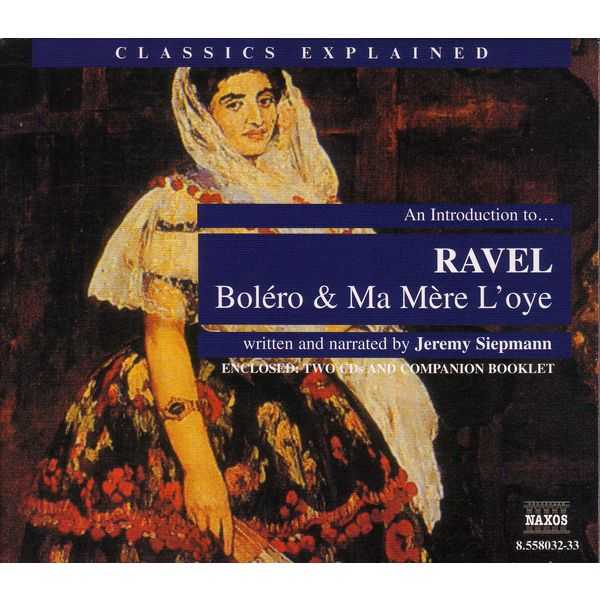
Composer: Maurice Ravel
Performer: Jeremy Siepmann
Format: FLAC (tracks)
Label: Naxos
Catalogue: 8558032-33
Release: 2001
Size: 361 MB
Recovery: +3%
Scan: yes
Bolero and Ma Mere L’oye
CD 01
01. Bolero-Introduction; cue to unadorned Bolero rhythm, Part 1
02. Bolero rhythm, Part 2: an extended variation of Part 1
03. ‘ Motto ‘ rhythm complete
04. But here we have snare drums and plucked violas and cellos
05. Section 1: Introduction of ‘ the theme ‘ by solo flute
06. Flute continues with Part 2 of theme
07. Section 2: Complete statement of theme by clarinet as flute joins ‘ motto ‘ group
08. Introduction of ‘ discordant ‘ harp into the unfolding picture
09. Section 3: Bassoon introduces closely related variant of theme
10. …but then veers upwards, slowing rhythm and introducing new syncopation
11. Section 4: ‘ Petite ‘ E flat clainet takes over theme, including variants
12. Section 5: Oboe d’amore takes over theme but returns to its original form
13. Section 6: Theme now shared by two instruments: uted trumpet and flute
14. Section 7: Tenor saxophone takes Theme as trumpet replaces horn in ‘ motto ‘
15. Section 8: Theme taken by soprano saxphone, ‘ espressivo ‘
16. Section 9: Theme: celeste, piccolos and horn; Motto: flute and French horn
17. Section 10: Theme: Oboes, horns, clarinets; Motto: plucked violas and violins
18. Section 11: Theme taken by First Trombone, complete with jazzy slides
19. Section 12: Theme: flutes, oboes, clarinets, sax; Motto: bassoons, horns, trumpets
20. Section 13: Violins at last take the main tune, joining massed winds
21. Section 14: Violins divide into four groups, each ‘ double-stopping ‘
22. Section 15: Trumpet, trombone 2 and tuba join the foreground
23. Section 16: First trombone and soprano saxophone ‘ rejoin ‘ theme
24. Section 17: Fortissimo; all strings ‘ double-stopping ‘; trumpets added
25. Section 18: Entire orchestra now employed, ‘ as loudly as possible ‘
26. Section 19: Sudden, amazing change of key, lurching from C to E Major
27. Section 20: Key now lurches back to C, as jazzy trombones whiningly protest
28. Cue to complete performance
29. Bolero (complete)
CD 02
01. Pavane de la Belle au bois dormant-Opening figure on flute; rising, falling, and then reeated
02. Same again, with emphasis on delicacy of scoring
03. answering variant, accompanied by plucked double basses
04. Reminder of opening figure
05. … and now its rhythmical mirror image, or almost…
06. Answering Phrase 2: a near-inversion, over ‘ James Bond ‘ accompaniment
07. Pivotal Phrase 3, reversing direction but keeping rhythm of Phrase 2
08. Reprise of Phrases 1 and 2, but with new accompaniment
09. Further Reprise of Phrase 2, now on violin, accompanied by harp
10. Pavane (complete)
11. Petit Poucet (Tom Thumb)-Introduction; Opening, with multi-metre rising scales from muted violins
12. Change of metre continue as solo oboe introduces Theme One
13. Oboe yields to Cor Anglais for Theme Two, against lower (still muted) strings
14. Theme One returns, shared by clarinet and flute, muted horn added to accompaniment
15. ‘Motto’ rhythm dominates as intensity increases from lower strings to full orchestra
16. Fear subsides as Theme Two returns, again in Cor Anglais but now in a different key
17. Sensational sound effects evoke a wood at night, with screeches, cuckooing etc.
18. Texture thins; Theme one returns, delicately scored for strings and piccolo
19. The main part of movement ends, with waltz-like march(!), featuring flute
20. Petit Poucet (complete)
21. Laideronnette, Imperatrice des Pagodes-Introduction; opening bars, followed by Theme One
22. Oriental-orchestral equivalent of an imprial telephone bell
23. … oboe ‘ answers ‘ with a very slightly varied version of Theme One
24. Expanded derivative of the ‘ telephone bell ‘ interrupts the theme again
25. Fragments of theme in flutes and cor anglais, with ‘ James Bond ‘ tag in violins
26. ‘Gamelan ‘ music from flute and piccolo, accompanied by harp, xylophone and strings
27. arrival of Empress; upper strings yield to winds, celeste, harp and (very discreet) gong
28. Laideronnette, Imperatrice des Pagodes (complete)
29. Les entretiens de la Belle et de la Bete- opening
30. Characteristic pattern of two short phrases answered by a long one
31. Clarinet, flutes and violas, with ‘ sighing’ figure derived from downward string motif
32. Varied reprise of opening, entry of the ‘ Beast ‘; ‘ Watch it ! Watch it ! ‘
33. Again the ‘ Beast ‘ growls; again the cautious warning ‘ Watch it ! ‘ from the winds
34. Derivative of Beauty’s Theme from flute, combined with ‘ caution motif ‘ in strings
35. ‘ Beast’s theme ‘ rises in pitch with each successive ‘ gowl ‘ (representing hope?)
36. ‘ Beauty ‘, ‘ Beast ‘ and ‘ Caution ‘ motifs all combine simultaneously
37. ‘ Beast ‘ (contra-bassoon) climbs ever higher, handing over to bassoon proper
38. Harp’s upward glide heralds the moment of transformation; love song, fear, release
39. Les entretiens de la Belle et de la Bete (complete)
40. Le jardin feerique-Introduction; Opening bars are unfuuuuuuuuurled by the strings alone
41. The rhythmic basis, and its guises. First, a question: ‘ Where went my childhood?’
42. The question intensified:’ Oh where went … my childhood?’
43. The answer, with a falling inflection: ‘ Gone is your childhood.’
44. The plea: ‘ Bring back my childhood!’
45. The response: ‘ Seek in … your mem’ry. There it … will be.’
46. Ravel’s use of tone colour to change the feeling of the music
47. Further illustration of the same point
48. Continued
49. The nobility of the strings
50. Bells evoked by French horns; the final, opulent, moving climax of the whole suite
51. Le jardin feerique (complete)